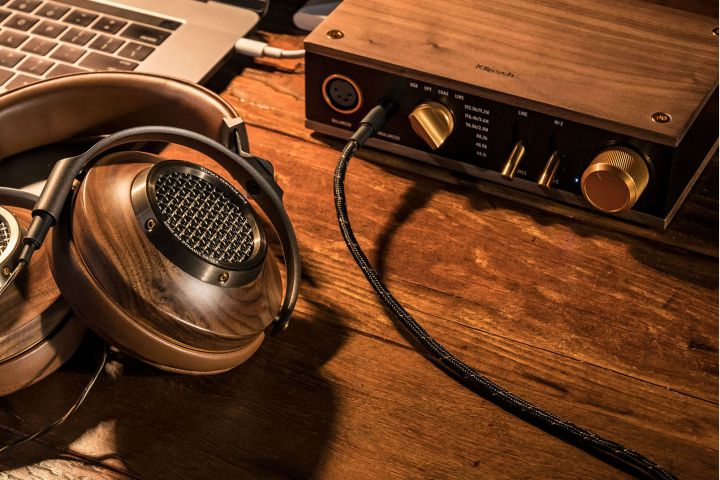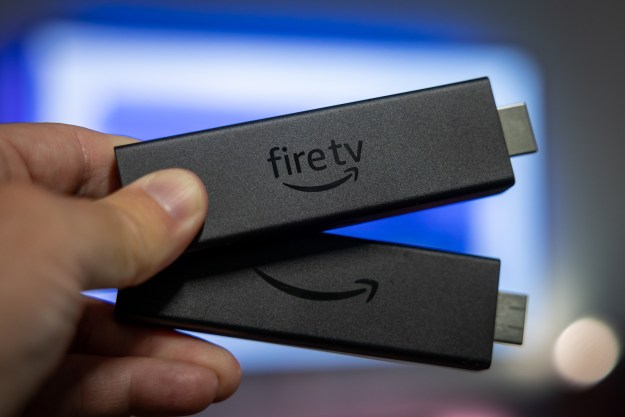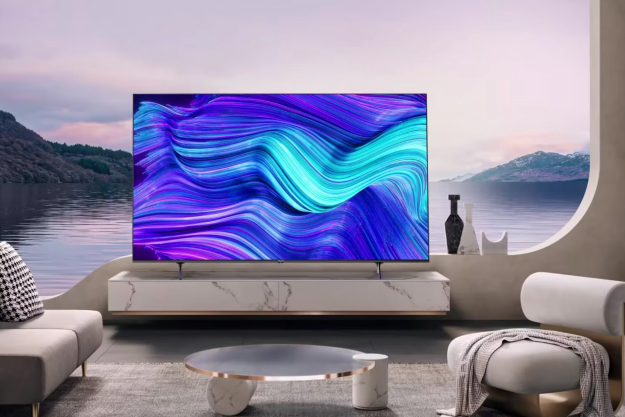These days, music is more accessible than ever and in increasingly rich audio formats. Gone are the days of struggling to unearth a quality MP3 from whatever reputable downloader you can find online. Now, all one has to do is sign up for a top music streaming service to choose from a myriad of audio codecs — from basic MP4 files to the remarkable quality of lossless tracks and impressive Dolby Atmos sound-staging. The only thing left to worry about is the type of headphones you’ll be using to experience these high-quality tracks.
While a top-rated pair of wired headphones can go a long way in enriching your listening experience, there are ways to push your chosen pair even further. That’s where a headphone amp comes into play.
If you’re reading this article, you probably care a lot about your wired headphones, and now you’re wondering if you can improve their performance with a headphone amp. The short answer is: Yes. Depending on your
What is a headphone amp?
A headphone amp is a relatively low-powered amplifier that raises the low-voltage audio signal from a source device (be it a turntable, PC, or smartphone) to a sufficient level such that it can be converted (or transduced) into sound waves by the speakers inside your headphones. It works like the amps used to power full-sized speakers but operates at a lower scale.
What is a DAC?
Most modern headphone amps also include an electronic component called a DAC (digital-to-analog converter). A DAC’s job is to convert digital audio information into a low-voltage signal that an amplifier can, well, amplify.

Analog components like a turntable or tape deck don’t need a DAC – they already put out analog low-voltage signals — but digital audio devices like PCs, smartphones, iPods, or tablets need both a DAC and headphone amp in order for you to hear sound through your headphones.
Why do I need a headphone amp?
All those digital devices we just mentioned already have a DAC and headphone amp built right in — that’s why you can just plug your headphones in and hear sound. Why, then, would you need a separate component?
Unfortunately, the quality of those built-in components varies greatly from device to device, and therefore, so does the sound quality. A MacBook Pro has a decent DAC and headphone amp built-in, so it sounds … decent … but many laptops, like the old Dell Inspiron N5110, for example, have very low-quality DACs and headphone amps, so they sound pretty bad. The same goes for phones: Some sound terrible, some are decent, and some — like the LG V60 ThinQ — sound superb.
Frankly, if you don’t have a good-quality pair of headphones (read: better than a pair of $30 earbuds), you won’t benefit from a headphone amp. But as the quality of
Does anyone need a headphone amp? That’s questionable. But might you want one? If you dig great sound, the answer is a resounding yes.
Impedance (aka, the numbers game)
There are also certain kinds of headphones that really do need a headphone amp to function properly: We call these high-impedance
For headphones, impedance can vary widely, from around 16 ohms on the low end to as high as around 600 ohms. Generally, the higher the impedance, the more amplification power is needed to drive the
Classic headphones like the high-end Sennheiser HD800 (300 ohms) and the cheaper but renowned Beyerdynamic DT990 (600 ohms) were originally designed for use in listening rooms and recording studios with powerful audio gear. Therefore, a headphone amplifier with more voltage than what’s available inside the average smartphone is needed to get these
Not all high-performance headphones are high-impedance, power-hungry monsters, though. As our audio sources have gotten smaller, headphone designers have adjusted. New technology makes high-performance

Most in-ear headphones — which naturally utilize smaller drivers that require lower voltage — also generally work fine with portable devices.
While there are no hard or fast rules, if your headphones have an impedance of, say, 50 ohms or higher, a headphone amplifier is probably a good idea — we would consider you to be in the need camp. If your cans are below 32 ohms, they’ll work fine with virtually any consumer audio device. With that said, you could still be in the want camp.
The sound quality quotient (i.e., the signal path)
Most commonly referenced in professional audio circles, the signal path — or signal chain — refers to any and all components that make contact with your audio signal. In our case, that likely includes a digital source, DAC, amplifier, a pair of headphones, and finally, your ears. The higher the signal-path quality is, the higher the sound quality will be. Though you can’t replace the last stop on the list (yet), the rest are all in play.
When matched up with good headphones, quality amplification can do some very cool things.
You may have landed here to learn about headphone amplification, but we’d be remiss if we didn’t point out that the DAC is an extremely important stop on the good train audiophile. The DAC is a critical portal between you and your sound because it changes the sound data from digital information — simple code consisting of 1s and 0s — into electrical current. The better that transference point, the better the sound.
Quality amplification can also improve sound quality for virtually any pair of headphones from around the $100 price point up; basically, any model built for sound quality over colorways and cute designs. When matched up with a good pair of

The best amplifiers and DAC solutions create a purer, clearer, and less distorted signal. The better the signal that reaches your headphones, the better your sonic experience will be.
What kind of headphone amp/DAC should I buy?
OK, so you’ve decided to pony up and buy yourself a dedicated amplifier or amplifier/DAC combo. That means it’s time to cash out that Apple stock, right? Not necessarily. There are a number of ways to up your headphone game, at a number of price points. We’ll go through a few to help get you started.
Going mobile
There are a wide variety of quality mobile headphone amp/DACs to choose from. On the high end (though they go much higher) are products like Shure’s excellent SHA900, which can push virtually any pair of headphones you can find (up to 600 ohms), offers versatile input connection and four-band parametric equalization, and high-resolution digital audio support at up to 24-bit/96kHz. If the $1,000 asking price is too rich for your blood, there are also much more affordable options like the $60 FiiO A3, which gets high marks from reviewers and can push
DAC attack
A relative newcomer to the headphone amp game, the USB DAC/headphone amp or DAC stick is one of the easiest ways to improve the sound directly from your computer’s USB output. While they require a laptop to take them on the road, they represent a supremely simple and affordable way to raise your signal-chain game. Our favorite at present is the DragonFly Red, which costs $200 and is claimed to be able to drive virtually any pair of headphones you can throw at it, even the “lowest efficiency” models like those referenced above. There’s also the DragonFly Black ($100) for your medium- to low-impedance cans. Another option we like is the Cambridge Audio DACMagic XS, which will also run you around $100 or less.
Desktop decision
The desktop headphone amp is a staple in the industry that should not be overlooked. While often pricey and bulky, these devices are anything but out of date or style for true audio fans, and many represent the absolute best way to take your daily audio to the next level. There are far too many types to outline here, but we’ll go over a couple of solutions that stand among our favorites at the moment.

Our previous choice, the Oppo HA-1, offered a healthy blend of digital and analog features for incredible functionality. Unfortunately, it’s no longer available (unless you can find it used), as the company went belly-up. Luckily, there are plenty of other top contenders on the market. One great option is the RME ADI-2. Built from the ground up as a formidable DAC and headphone amp, the ADI-2 comes loaded with digital optical and coaxial outputs, analog RCA outputs, an onboard Line Out EQ monitor, and an Extreme Power headphone output for delivering the ADI-2’s ultra-refined signal directly to your favorite audiophile headphones.

Our other pick is the decidedly old-school cool Kenzie tube headphone amp from Amps and Sound. Those glowing tubes on the top will pull in plenty of admirers, while also perfectly outlining our point about sound coloration. Illustrating our previous point about colorization, where the Heritage amp is fizzy and vibrant, the Kenzie is warmer, richer, and smoother. One of the few options on our list that isn’t a DAC/amplifier combo, the Kenzie sources analog sound from your preferred output, and is therefore dependent upon your DAC. The sound is also a shade noisier than more modern amps, including the Heritage. Even when connected to a basic headphone output, though, the Kenzie brings magic to your mix, and should get serious consideration from those with a great pair of over-ears.
Editors' Recommendations
- What is HDR TV? High dynamic range and why you need it
- What is a network music streamer and why do you need one?
- What is a DAC and why would you need one?
- Astell&Kern blurs the line between headphone amp and digital audio player
- What you need to know before upgrading your Sonos system to S2 software



